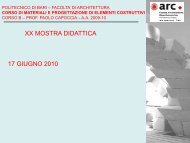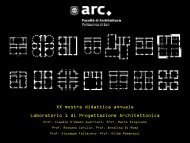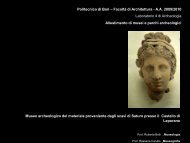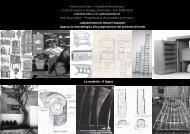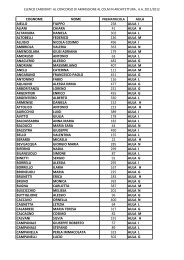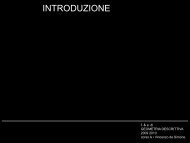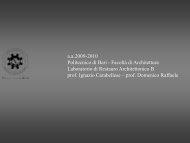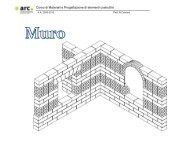44. I regolamenti <strong>di</strong>dattici100Teorie e storia del restauroTheories and History of ArchitecturalRestorationIcar 19 - 4 cfu3° anno / corso semestrale (I semestre)Area <strong>di</strong>dattica III:Teoria e tecniche per <strong>il</strong> restauroarchitettonicoRossella De Cad<strong>il</strong>hacFinalità e contenuti <strong>di</strong>sciplinariIl corso si propone <strong>di</strong> presentare i fondamentiteorici e culturali del restauro architettonico,focalizzare le convergenze e le <strong>di</strong>vergenze <strong>di</strong>pensiero sincroniche e <strong>di</strong>acroniche, coglierela complessità inter<strong>di</strong>sciplinare della materia,al fine <strong>di</strong> formare futuri architetti capaci <strong>di</strong>operare con consapevolezza storico-critica sumonumenti che reclamano la necessità <strong>di</strong> unrestauro.Aims and contentsThe course introduces the theoretical andcultural basis of architectural restoration, tofocus on the convergences and <strong>di</strong>vergencesof thought, to gather the inter<strong>di</strong>sciplinarycomplexity of the subject with the purpose oftraining future architects able to operate withhistorical and critical awareness onmonuments that need to be restored.Articolazione delle attività <strong>di</strong>datticheIl corso si articola in una serie <strong>di</strong> lezioni excathedra,<strong>di</strong> incontri con ospiti esterni e <strong>di</strong>incontri seminariali. Questi ultimiconsisteranno nell’approfon<strong>di</strong>mento <strong>di</strong> untema monografico, che potrà essereintrapreso singolarmente o in gruppo (maxdue componenti), concordato con la docentee che sarà sottoposto a revisioni perio<strong>di</strong>chein aula aventi carattere seminariale.LezioniIl corso traccia un quadro generale della<strong>di</strong>sciplina, percorrendo la storia e le teorie delrestauro in Italia e in Europa, conapprofon<strong>di</strong>menti specifici. In particolarevengono indagati:-<strong>il</strong> variare del concetto <strong>di</strong> monumento neltempo;-<strong>il</strong> Settecento e la nascita del restauromoderno;-<strong>il</strong> restauro in Francia nell’Ottocento;-gli orientamenti estetici e letterarinell’Ingh<strong>il</strong>terra del Settecento;-i criteri-guida, la prassi e <strong>il</strong> <strong>di</strong>battitoarchitettonico in Italia alla metàdell’Ottocento;-la propagazione europea del restaurost<strong>il</strong>istico;-l’interesse per <strong>il</strong> tema urbano;-la Conferenza <strong>di</strong> Atene e la Carta del restaurodel 1931;-la teoria <strong>di</strong> Cesare Bran<strong>di</strong>;-la pluralità <strong>di</strong> posizioni nel <strong>di</strong>battito attuale..Articulation of educational activitiesThe course consists of a series of lessons,meetings with external guests and seminars.These latter ones w<strong>il</strong>l consist of deepening amonographic theme, that can be undertakensingly or in groups (max two people),arranged with the teacher and that w<strong>il</strong>l besubmitted to perio<strong>di</strong>c revision in class.TopicsThe course traces a general picture of the<strong>di</strong>scipline, crossing the history and thetheories of the restoration in Italy and inEurope, with specific examples. In particularthe following are investigated:- the change of the concept of monumentsover time;- the eighteenth century and the birth ofmodern restoration;- restoration in France in the nineteenthcentury;- the aesthetical and literary orientations inEngland in the eighteenth century;- the guide lines, the routine and thearchitectural debate in Italy in the middle ofthe nineteenth century;- the European propagation of stylisticrestoration;- the interest in the urban theme;- the meeting of Athens and the restorationcharter of 1931;- Cesare’s Bran<strong>di</strong> theory;- the plurality of positions in current debate.Iscrizione al corsoLe iscrizioni devono effettuarsiobbligatoriamente sulla piattaforma, entrole prime due settimane del corso.Modalità d’esameSi prevedono tre verifiche interme<strong>di</strong>econsistenti ciascuna in una prova scritta. Laverifica conclusiva terrà conto del colloquiosulla parte istituzionale del corso e dellafrequenza durante <strong>il</strong> semestre.Non si può sostenere l’esame <strong>di</strong> Teorie eStoria del Restauro se non si è superatol’esame <strong>di</strong> Storia dell’Architettura Moderna.Scienza delle costruzioniScience of ConstructionIcar 08- 8 cfu3° anno / corso annualeArea <strong>di</strong>dattica IV:Analisi e progettazione strutturaledell’architetturaSavatore MarzanoP<strong>il</strong>ade FotiFinalità e contenuti <strong>di</strong>sciplinariIl corso si propone <strong>di</strong> fornireun’introduzione ai principi, meto<strong>di</strong> eproblemi della scienza delle costruzioni,riguardata come integrazione dellameccanica dei soli<strong>di</strong>, dei materiali e dellestrutture.Un fondamento teorico è costituito dallameccanica dei soli<strong>di</strong> che viene presentatanel suo assetto attuale e nelle sue relazionicon l’evoluzione della ricerca teorica esperimentale sul comportamento deimateriali da costruzione.Altro fondamento è costituito dallameccanica delle strutture che vieneaffrontata nei problemi più r<strong>il</strong>evanti per laprogettazione strutturale.Aims and contentsThe course provides an introduction to theprinciples, methods and problems of thescience of materials, intended as anintegration of solid mechanics, mechanicsof material and structural mechanics. Thetheoretical basis consists of SolidMechanics, which is presented in its mostrecent development but also in relation tothe evolution of theoretical and
experimental research into the behaviourof construction materials. Anotherfundamental area of study is representedby Structural Mechanics, that w<strong>il</strong>l betreated with particular attention to themost relevant problems concerningstructural design.Articolazione delle attività <strong>di</strong>datticheLezioniNell’ambito del corso verranno affrontati iseguenti argomenti.1 Cenni <strong>di</strong> algebra tensoriale.2 Deformazione.3 Sforzo.4 Relazione sforzo-deformazione.5 Isotropia elastica.6 Problema <strong>di</strong> Saint-Venant.7 Criteri <strong>di</strong> resistenza.8 Statica delle travature.9 Travature elastiche.10 Instab<strong>il</strong>ità elastica.Alla fine del corso l’allievo sarà in grado <strong>di</strong>adoperare gli strumenti fondamentali dellameccanica dei soli<strong>di</strong>, dei materiali e dellestrutture. In particolare, egli sarà in grado<strong>di</strong> affrontare i problemi <strong>di</strong> verifica eprogettazione, nel caso dei più significativischemi strutturali adoperati attualmentenella costruzione degli e<strong>di</strong>fici.Articulation of educational activitiesTopicsDuring the course, the following subjectsw<strong>il</strong>l be covered:1 Basic tensorial algebra.2 Strain.3 Stress.4 Stress-strain relationship.5 Elastic isotropy.6 The De Saint-Venant Problem.7 Strength criteria.8 The Statics of beams.9 Elastic beams.10 Elastic instab<strong>il</strong>ity.At the end of the course, the student w<strong>il</strong>l beable to use the fundamental tools of SolidMechanics, Mechanics of Materials andStructural Mechanics. In particular, he orshe w<strong>il</strong>l be able to face the problems ofverification and design with regard to themost representative structural schemescurrently used.Iscrizione al corsoLe iscrizioni avvengono obbligatoriamentesulla piattaforma. Per iscriversi lo studentedeve avere sostenuto tutte lepropedeuticità previste. È ammessal’iscrizione con riserva per quegli studentiche sosterranno tutte le propedeuticitàpreviste entro la sessione invernale. Lamancata verifica <strong>di</strong> questa con<strong>di</strong>zioneimplica a febbraio l’automatica decadenzadalla iscrizione al corso.Modalità d’esameDurante <strong>il</strong> corso sono previste due prove <strong>di</strong>esonero <strong>di</strong> cui una <strong>di</strong> tipo progettuale.L’esame consiste in una prova scritta e inuna prova orale..Tecnologia dell’architetturaTechnology of ArchitectureIcar 12-4 cfu3° anno / corso semestrale (II semestre)Area <strong>di</strong>dattica V:Discipline tecnologiche per l’architetturaVitangelo Ar<strong>di</strong>toFinalità e contenuti <strong>di</strong>sciplinariIl corso è volto ad integrare le conoscenzeacquisite nei precedenti corsi <strong>di</strong> ambitotecnologico e sperimentarne le implicazioninei casi <strong>di</strong> strutture e sistemi <strong>di</strong> maggiorecomplessità, me<strong>di</strong>ante l’introduzione <strong>di</strong>categorie capaci <strong>di</strong> analizzare l’innovazionedei processi ed<strong>il</strong>izi, valutarne l’efficacia einterpretarne le linee evolutive.Aims and contentsThe course aims to integrate thetechnological knowledge acquired in theprevious years and to experiment theirimplications in structures and morecomplex systems, through the introductionof categories able to analyze the innovationof the bu<strong>il</strong><strong>di</strong>ng process, to appraise itseffectiveness and to interpret itsevolutionary lines.Articolazione delle attività <strong>di</strong>datticheIl percorso <strong>di</strong>dattico prevede una primaserie <strong>di</strong> lezioni de<strong>di</strong>cate all’evoluzione deisistemi costruttivi (materiali, lavorazioni,processi, cantiere) attraverso l’<strong>il</strong>lustrazione<strong>di</strong> e<strong>di</strong>fici significativi che ne mostrano lacomplessità; una seconda volta adanalizzare le parti componenti l’organismoarchitettonico. Alcuni cenni sarannode<strong>di</strong>cati al significato attuale <strong>di</strong> progetto e<strong>di</strong> dettaglio esecutivo.1.a serie <strong>di</strong> lezioni• Caratteri e tecniche del costruire nellecostruzioni della Grecia classica.• Principi costruttivi e tecniche esecutivenelle costruzioni romane: <strong>il</strong> Pantheon e labas<strong>il</strong>ica <strong>di</strong> Massenzio.• La costruzione della cattedrale gotica.• Brunelleschi e Michelangelo: tecniche,maestranze e materiali in S. Maria del Fiorea Firenze e S. Pietro a Roma.• L’evoluzione della forma strutturale:Alessandro Antonelli e Pierluigi Nervi.• Architettura e tecnica nel progettomoderno contemporaneo.• Il principio del rivestimento nel processo<strong>di</strong> rinnovamento dell’architettura moderna.2.a serie <strong>di</strong> lezioni• Le gran<strong>di</strong> coperture murarie, in metallo,in c. a., in legno.• Le chiusure verticale ed orizzontalicomplesse. Le partizioni interne.• La soluzione dei no<strong>di</strong> tettonici e delle<strong>di</strong>scontinuità murarie.• Teoria delle interferenze tra sistemi,giunti e tolleranze;• Cenni sul significato <strong>di</strong> progetto e <strong>di</strong>dettaglio esecutivo.Articulation of educational activitiesThe course develops is articulated in one firstcycle of lectures de<strong>di</strong>cated to the evolution ofthe constructive systems (material,workmanship, processes, construction site,etc.) through the <strong>il</strong>lustration of significantbu<strong>il</strong><strong>di</strong>ngs capable to show the complexity; thesecond cycle analyze the components of the44.2.10 Progetti <strong>di</strong>dattici del II ciclo del CdLm in Architettura101
- Page 1:
0607Politecnico di BariFacoltà di
- Page 4 and 5:
Politecnico di Bari, Facoltà di Ar
- Page 6 and 7:
4. Regolamenti didattici4.1. Il Reg
- Page 8 and 9:
PresentazionePresentazioneLa Facolt
- Page 11 and 12:
Le strutture didattiche e di suppor
- Page 13 and 14:
giorno e dando, quindi, esecutivit
- Page 15 and 16:
• esprimere pareri sui compiti di
- Page 17 and 18:
1.3. La Biblioteca di FacoltàIl pa
- Page 19 and 20:
2. Strutture di ricerca e di suppor
- Page 21 and 22:
BIO 07, Ecologia43 Mariavaleria Min
- Page 23 and 24:
le richieste e le iniziative ad ess
- Page 25:
2.3 Le biblioteche d’area2.3.1 Le
- Page 28 and 29:
33. La didattica e gli studenti263.
- Page 31 and 32:
4. I Regolamenti didattici4.1. Rego
- Page 33 and 34:
presente regolamento;• le propede
- Page 35 and 36:
discussi ed i voti finali.Per ciasc
- Page 37 and 38:
4.2.4 Definizione delle aree discip
- Page 39 and 40:
laurea da attivare in base al numer
- Page 41 and 42:
non venga superato l’iscrizione a
- Page 43 and 44:
Manifesto del CdLs in Architettura
- Page 45 and 46:
Manifesto del CdLm in Architettura
- Page 47 and 48:
ciclo provenendo da altri Atenei.È
- Page 49 and 50:
Manifesto del CdLs in Architettura
- Page 51 and 52: Manifesto del CdLm in Architettura
- Page 53 and 54: Insegnamenti ssd Crediti Laboratori
- Page 55 and 56: Insegnamenti ssd Crediti Laboratori
- Page 57 and 58: Insegnamenti attivati e docenti per
- Page 59 and 60: Insegnamenti attivati e docenti per
- Page 61 and 62: Finalità e contenuti disciplinariN
- Page 63 and 64: Lezioni- L’architettura etrusca e
- Page 65 and 66: ibliografiche, volte ad acquisire g
- Page 67 and 68: Discipline tecnologiche per l’Arc
- Page 69 and 70: Istituzioni di geometria I + Istitu
- Page 71 and 72: architettonicoTopicsLife drawing, u
- Page 73 and 74: • Representation of the shadows
- Page 75 and 76: frequenza del corso che consentel
- Page 77 and 78: capacità di valutazione storico-cr
- Page 79 and 80: scale edilizie e tra diversi tipi;
- Page 81 and 82: planning of Roman suburban andcount
- Page 83 and 84: mutation through the works of the p
- Page 85 and 86: -Equazioni indefinite di equilibrio
- Page 87 and 88: coerenza tra qualità funzionale, c
- Page 89 and 90: transformations (psychrometry).In t
- Page 91 and 92: madrepatria.4. La colonizzazione e
- Page 93 and 94: EtruscologiaEtruscologyL-ANT/07 - 4
- Page 95 and 96: Archeologia e Storia dell’Arte Ro
- Page 97 and 98: The student will develope the archi
- Page 99 and 100: tanto il rapporto tra elementi, str
- Page 101: sociale dell’abitare (Loos, Tesse
- Page 105 and 106: Articolazione dell’attività dida
- Page 107 and 108: Aims and contentsThe Urban Sociolog
- Page 109 and 110: nell’ambito dell’annuale “mos
- Page 111 and 112: di laurea. Sarà quindi necessario
- Page 113 and 114: - Ancient modern Rome: the continui
- Page 115 and 116: During the lessons, theoretical and
- Page 117 and 118: Le esercitazioni costituiscono lo s
- Page 119 and 120: typological and technical innovatio
- Page 121 and 122: • la fenomeni di propagazione del
- Page 123 and 124: Aims and contentsThe urban economy,
- Page 125 and 126: value of a civil apartment with the
- Page 127 and 128: l’elaborazione della tesi di rice
- Page 129 and 130: 4.3.8 Esame di laureaPer essere amm
- Page 131 and 132: semestrale• Laboratori di sintesi
- Page 133 and 134: 4.3.14 Manifesto del CdL in Disegno
- Page 135 and 136: 4.3.16 Organizzazione delle attivit
- Page 137 and 138: 4.3.17 Insegnamenti e docenti per a
- Page 139 and 140: Laboratorio di Disegno industriale
- Page 141 and 142: • metodo dell’assonometria;•
- Page 143 and 144: fine dell’Ottocento; le avanguard
- Page 145 and 146: Iscrizione al corsoLe iscrizioni av
- Page 147 and 148: Laboratorio di Arredamento 2/IInter
- Page 149 and 150: Disegno 2/IIDrawing 2/IIIcar 17-5 c
- Page 151 and 152: communication, as follows:• typog
- Page 153 and 154:
4.3.22 Progetti didattici3° anno
- Page 155 and 156:
sintetiche, segnaletica interna ed
- Page 157:
esercitazioni pratiche, attività d
- Page 160 and 161:
55. Relazioni internazionali1585.1
- Page 163 and 164:
6. Post Lauream6.1. Dottorato di Ri
- Page 165 and 166:
Attività di ricercaLo svolgimento
- Page 167 and 168:
particolari e specifiche competenze
- Page 169 and 170:
iscrizione all’esame di ammission
- Page 171 and 172:
scientifico-disciplinare in cui è
- Page 173:
• alla sicurezza statica (corrett
- Page 176 and 177:
a.1 Planimetria del campus epiante
- Page 178 and 179:
Status accademico dei docentiDocent
- Page 180 and 181:
aAppendici178A.3 Indice dei nomiAAc
- Page 182 and 183:
aAppendicia.5 Calendario annuale de




